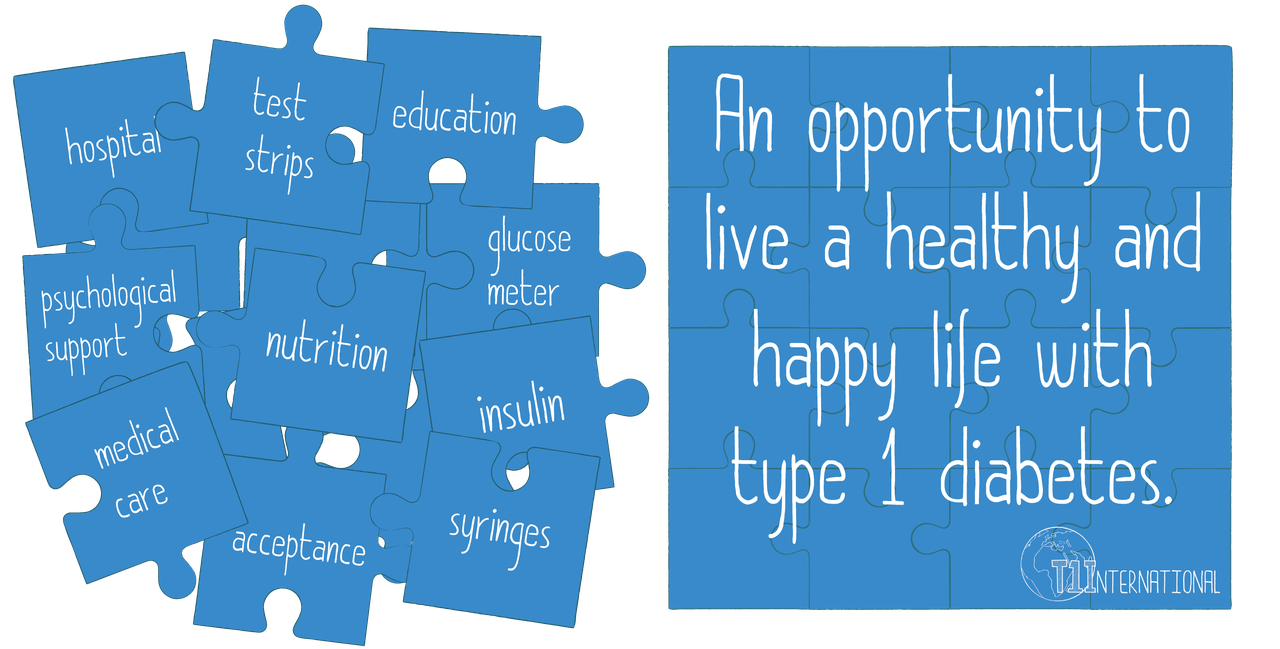
The Puzzle of Type 1 Diabetes
5 May 2015, 2:41 p.m. in Global Stories by Elizabeth Pfiester
For those that live with and understand type 1 diabetes, this graphic needs no introduction. For others, let me explain the importance of understanding the diabetes puzzle. Unlike many other health conditions (not all, but many!) that require a simple treatment – one medication, one procedure, one emergency routine, etc. – treating type 1 diabetes is like putting together a puzzle. There are so many pieces that need to be put together correctly in order to have a fair chance at a full life with type 1 diabetes.
People with type 1 diabetes need to take insulin via injection (or insulin pump) because our bodies no longer make the hormone. Insulin keeps a person with type 1 diabetes alive and is vital for our survival, but a person with type 1 cannot survive if they don’t have the syringes or tubes to administer it.
Even if we do have the means to get insulin into our bodies, we won’t succeed at a life with diabetes or last very long if we do not have a way to regularly test our blood sugar levels. This is vital to help us determine how much insulin we need to administer to lower our blood sugar or the amount of carbohydrates we need to eat to bring our blood sugar level up. In some parts of the world, technology has advanced to such a level that people with type 1 diabetes can almost constantly measure their blood glucose levels with something called a Continuous Glucose Monitor (CGM) which is a sensor that sits subcutaneously in the skin, measuring the amount of glucose (sugar) in the blood and sending those readings to a small machine that the person with diabetes can look at on a graph.
This advancement to CGM devices has made life better for so many with type 1 diabetes. However, it is astonishing that we have come so far, yet many children and adults with type 1 around the world do not have the means to test their blood sugar levels at all. If some are lucky enough to get insulin, they may have no idea if their blood sugar is high or low. The immediate danger of not having a glucometer and test trips is hypoglycaemia (lack of glucose in the blood), which could cause seizures or coma and death. The long-term danger is hyperglycaemia (too much glucose in the blood) which can cause kidney damage, blindness, or a different triggering of coma and death.
And this is just the tip of the iceberg. In the United Kingdom where I live, psychological support and mental health for people with type 1 diabetes is finally getting some attention. It is such an important piece of the puzzle. Living with type 1 diabetes is a 24/7 gig. It is also nearly 100% the responsibility of the individual living with it (or the parent or carer of someone living with it) to test blood sugar, factor insulin doses, count carbohydrates, and think about things that may increase or decrease blood sugar levels. For this reason, people with type 1 diabetes need some help with the mental burden of being solely responsible for something that is incredibly difficult to control.
Across the world, more attention needs to be focused on psychological support, but this piece of the puzzle is non-existent for people who can’t access the basics. For them, the education piece of the puzzle – which is also vital – is sometimes only a pipe dream. Can you imagine having some or all of the tools to manage your type 1 diabetes, but not having a real understanding of your condition or how to manage it? What if you had no sense of carbohydrate counting or very little understanding of the need to adjust the amount of insulin you need depending on your activity level and food consumption? Many of us struggle with the complexities of diabetes despite having a lot of the kit and tools that exist – but to not have the tools at all? That’s hard to imagine.
Suffice it to say, until a cure is found for everyone worldwide, type 1 diabetes is a puzzle of a condition and those of us that live with it are working to solve that puzzle day in and day out. Without each piece intact, the puzzle will be impossible to complete. Everyone, no matter where they live, needs each and every piece in its entirety so that they have at least a chance at a happy and healthy life with type 1.
If you agree, sign our Type 1 Diabetes Access Charter and take action today.



